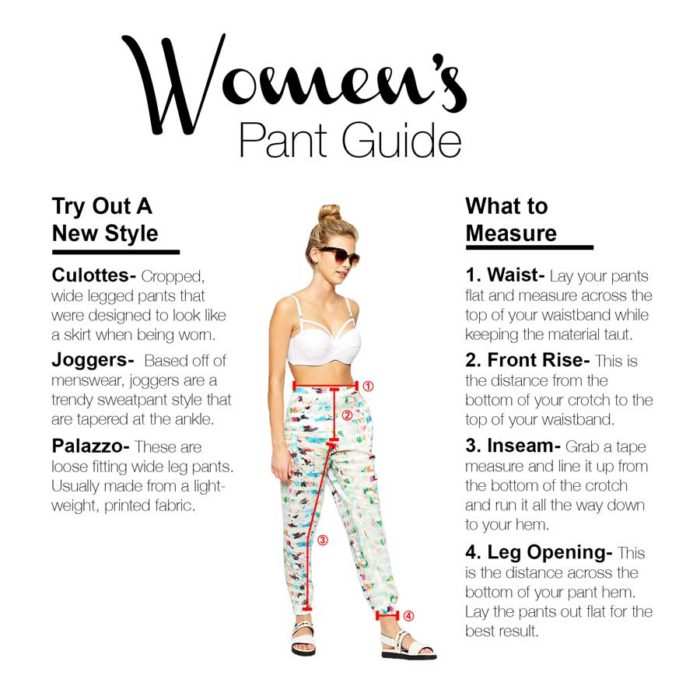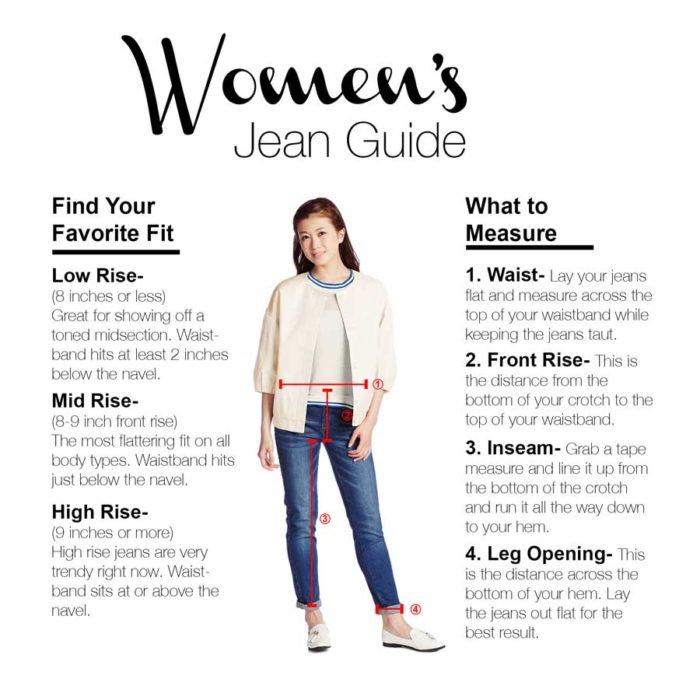With so many online shopping options, it’s hard to know what product or style is best for you. If you’re wondering what kind of jeans are most flattering for your body type you can check out my post Jeans For Every Body. Once you know the style that you’re looking for, you need to find out your measurements. Keep reading below for a quick guide on what measurements you should take for various articles of clothing. With this handy dandy guide and some practice you’ll be a savvy shopper in no time!
TOPS
Length: This determines the entire length of your top; from the top of your shoulder to the bottom hem. Some ladies need different lengths in tops so this measurement is helpful in finding a fit that’s right for you. To find your perfect length: lay out a top that you love the length on, make sure all the wrinkles are smoothed out, measure from the top of the shoulder or strap to the very bottom, and voila you have your desired length. Remember that length can be affected by straps, shirt style, and asymmetrical hems so you should take this into account when you shop online. Different retailers also measure their length differently so make sure and check their guide to see their process.
Bust: This is probably the most important measurements when it comes to tops. Let’s be honest, if a top can’t fit the girls comfortably then it doesn’t deserve to take up room in your closet. You can have a friend take this measurement on you by having a tape measure run under your arms and around your bust at the fullest part. All of our garments are measured when they are laying flat so we measure across the chest at the widest part. This means that you will need to double our measurement for the full circumference.
Sleeve Length: This one is not as easy as it seems. There are many ways to measure sleeve length so we simplified our measurements by just measuring the length of the outer edge of the sleeve that falls past the shoulder. To find out how long you like your sleeves or where a certain shirt will fall on you simply measure using the technique described above. Sleeve length isn’t a major measurement, but it can be helpful when determining if a top is right for you! Remember, sleeve length can also be affected by the style and fit of the shirt so take this into account when you’re shopping away.
Jeans + Pants
Inseam: This one is really important because it determines the length of your pants. The average inseam is about 30 inches depending on the style and fit that you like. Petite or cropped pants will be shorter and long jeans can go up to 36 inches. To find your inseam, lay your pants flat and measure the distance from the bottom of the crotch to the end of the hem.
Leg Opening: This measurement determines the style of your pants. Skinny legs will have a smaller leg opening than flared pants. Super skinny jeans can have a leg opening as small as 8 inches around while bell bottoms can go well past 20 inches. Our measurements are taken while the jeans are laying flat, so you will need to double the number to know the circumference of the leg opening. To find your desired style, measure across the very bottom hem of your pant while it’s laying flat and you will have your leg opening measurement.
Waist: This can be a tricky one, but it is well worth the time because it helps determines where the jeans will sit and how they will fit across your tummy. If the jeans you’re measuring are low rise then you can expect a larger waist measurement since they are sitting lower on the hips; likewise, if you have a high rise pant then the measurement will most likely be smaller. Measure across the very top of the waistband while the jeans are laying flat. Make sure the zipper and buttons are closed and that the waistband is taut because this will affect your measurements. Please note that different sellers measure the waist differently. We find our waist measurement by technique listed above.
Front Rise: This is the measurement that determines where your jeans will sit on your waist. Low rise pants measure about 7 inches and high rise pants can go upwards of 10 inches. Some styles of jeans can even have different front and back rises if they add extra coverage for your backside or if they are a curvy fit. To find your front rise measurement lay your jeans flat and measure from the bottom of the crotch to the top of the front waistband. Don’t measure all the way to where the jeans would hit on your backside, only measure to where top of the band where the button is located.
SKIRTS
Waist: To find your most flattering fit, knowing your waist measurement is crucial! Measure across the very top of the waistband while the skirt is laying flat. Make sure any zippers or buttons are closed and that the waistband is taut because this will affect your measurements. Remember, all skirts are designed differently so while some are made to sit higher on the waist, others are made to drape on the hips. A high rise pencil skirt will most likely have a smaller waist than a low rise denim mini of the same size.
Length: Ever tried on a skirt and thought “what in the world was i thinking?” If so, then you know that length can make all the difference when it comes to skirts. Measure the entire length of the skirt from top to bottom. Remember that asymmetrical hems can affect your measurements. We take our length measurement on the front of the skirt, along the seam.
DRESSES
Bust: This is a very important measurement when it comes to dresses because if the girls can’t fit comfortably then it isn’t the dress for you. You can have a friend take this measurement on you by having a tape measure run under your arms and around your bust at the fullest part. All of our garments are measured when they are laying flat so we measure across the chest at the widest part. This means that you will need to double our measurement for the full circumference. When you use the bust, waist, and length measurements together you are sure to find a fit that you love!
Waist: The waist is the skinniest part of the torso; however, dresses are known for changing where a waistline sits to make a flattering silhouette. Bodycon dresses emphasize a woman’s curves, empire waist dresses have a higher waist for a slimming effect, and shift dresses have no waist at all. Because of the varying waistlines, the waist measurement on dresses is only taken when the waist is a factor in fit. For example, in a babydoll dress it is loose fitting throughout so the waist would not be a factor, but in a bandage dress the waist would definitely be a factor when considering if a dress will fit.
Length: If you’ve ever tried on a dress and noticed that it looked much longer on the mannequin then you know that this is a very important measurement. Even if you aren’t concerned with how long a particular style is, the length can be helpful in knowing where a dress will fall on your body. To find the length measure from the very top of the straps (if there are any) to the bottom of the hem. We take this measurement on the front of the dress while it is laying flat.
SHORTS
Waist: This can be a tricky one, but it is well worth the time because it helps determines where the shorts will sit and how they will fit across your tummy. If the shorts you’re measuring are low rise then you can expect a larger waist measurement since they are sitting lower on the hips; likewise, if you have a high rise pant then the measurement will most likely be smaller. Measure across the very top of the waistband while the shorts are laying flat. Make sure the zipper and buttons are closed and that the waistband is taut because this will affect your measurements. Please note that different sellers measure the waist differently. We find our waist measurement by technique listed above.
Inseam: This one is really important because it determines the length of your shorts. The average inseam on short shorts can vary from half and inch to 2 inches depending on the style and fit that you like. Cuffed shorts or Bermudas will be longer. To find your inseam, lay your shorts flat and measure the distance from the bottom of the crotch to the end of the hem. Some shorts are asymmetrical so take this into account when you take your measurements.
SHOES
Heel Height: This is crucial in ensuring that you have a comfortable, walk-able heel. Measure from the back of the heel to find your heel height. Some retailers measure from the front or center of the heel but we find our measurement by measuring form the back. Start at the heel pad and measure to the base of the shoe.
Platform Height: Find this one by measuring the platform found on the front of the shoe. Many styles won’t have this so don’t be worried if you can’t find this. Usually this measurement will be reserved for high heels since a platform will offset a higher heel.
Calf Width: This one only applies to boots, but it is one of the most important measurements if you don’t have twig legs. We find our width by measuring across the center of the calf as pictured. Find your needed size by measuring around the widest part of your calf. Cut your number in half and that is the minimum width that you can use.


